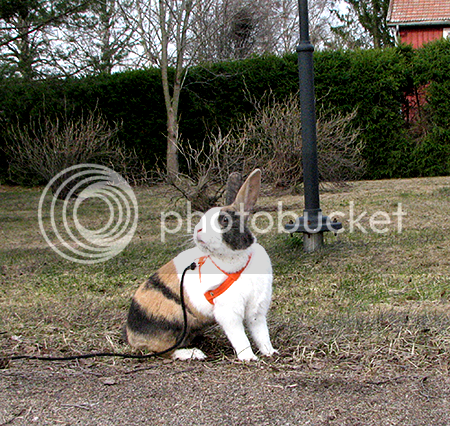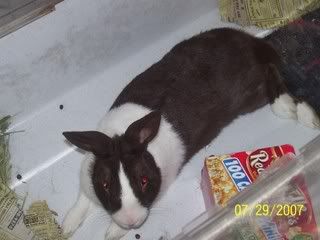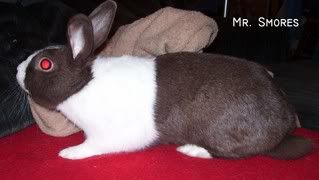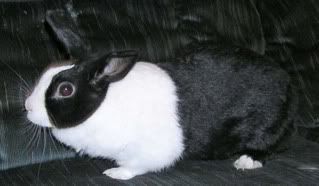bunnylover78642
Well-Known Member
[align=left]Dutch.[/align]
[align=left]The dutch rabbit Is popular with fanciers and pet lovers alike whether true or mismarked theymake people fall in love with them. It is a smallish rabbit with very striking markings in a variety of colours including tridutch.[/align]
[align=left]Weighs in at 4 1/2 - 5lbs (2.041-2.26kgs)
[/align]
[align=left]Appearance.[/align]
[align=left]The dutch rabbit isa fairly small and compact rabbit with erect ears and powerful back legs. Popular as a breed they are classed as a white rabbitwearing formal attire. Their markings should be clean cut between the white and the colour, as this is where a lot of the points are awarded when showing. A dutch will alwyas stand out from the crowd!
History.
The dutch rabbit was developed in England during the 1830's. They origionated from a breed called the "petite Brabancon." (which have pictures back as far as the 15th century!)
The Petite Brabancon were brought over from the netherlands for meat and would often display dutch markings! UK breeders selected the rabbts with the ost even markings and changed it into the breed it is today.
Health.
Dutch are generally a very healthy and hardy breed that live on average 5 to 8 years.
Breeding.
Raising well-marked Dutch is not an exact science.You can breed two perfectly marked Dutch together and get a wholelitter of mismarks. You can breed two mismarks and get awhole litter of perfectly marked Dutch. You can breed a doeand a buck once and get a nicely marked litter, breed them again andthe litter is mismarked. The point is that you can't breed for markings. But this obstacle is what makes raising Dutch so much fun.
If you can't breed for markings, how can you breed for a goodDutch? First, when picking out your breeding stock, you must consider type first. A good typed Dutch should have thecompact type comparable to a Mini Rex or Florida White. Goodtype is smooth with full hindquarters and shoulders. What Il ook for is a side profile that is a �u� but broader. Thehead should be as round as possible. Fur should be flybackand shiny. Color will of course, depend on the variety you want. You will want to talk to an experienced breeder about proper color and what colors you can mix. Generally color tocolor (such as black to black) is best.
The most exciting part about raising Dutch is when you get your first litter. You can immediately go through the babies tosee what their markings look like. If you have all mismarks,it's not the end of the world. In most cases, there will bean awesome typed baby in there. You can take the best typed baby, breed it and then get some nicely marked babies. In my experience, the mismarks usually throw the best marked babies.
If you have a couple showable babies, you will need to wait to see what their type turns out like. Showing Dutch isn't justabout markings. Type is just as important. But ifyou start with nicely typed Dutch, you shouldn't have too much to worry about.
The biggest factor in raising good Dutch is patience.But there is nothing more rewarding than getting that Best in Show witha rabbit you raised yourself!
Dutch rabbits will have an average liiter size of 6 though you can expect to see as little as 4 or as many as 10!!
Personality.
Dutch are a very intelligent and easily trained. They do tend to get bored easily, so plenty to interest them is a must! They are known for having a great nature and are very gentle and sociable rabbits. Ideal as a pet or for breeding/showing with.
ARBA standards
Varieties: Black, blue, chocolate, gray, steel, tortoise
Sr. Bucks & Does - 6 months of age or over, weight 3 1/2 -5 1/2 lbs. Ideal weight 4 1/2 lbs.
Jr. Bucks & Does - under 6 months of age. Min weight 1 3/4 lbs
Schedule of points.
Type = 25 points.
Body - 12 pts
head- 5pts
ears- 2 pts
eyes- 1pt
----------------------------
Fur= 10points
colour = 10points
------------------------------
Markings = 50 points
cheeks - 12 pts
Blaze - 5 pts
Neck - 5pts
Saddle - 10pts
Undercut - 8 pts
Stops- 10pts
condition- 5 pts
----------------------
Overall = 100 points.
UK Standard.
Ring size B.
Ears - 10pts short and strong, not pointed at ends and fairly broad at the base.
Eyes - 5pts Bold and bright. should be fairly large
Blaze and cheeks - 15pts Blaze shoud be wedge shaped and carrying up to a point between ears. Cheeks to be as round as possible and come as close to whiskers as possible without touching. Should also cover jaw bone.
Clean neck - 10pts Should be free from coloured fur immediately behind ears.
Saddle - 10pts The junction between white and coloured fur on back. It should be right round the animal and be an even straight line.
Undercut - 10pts To be as near to front legs as possible without touching.
Stops - 15pts White markings on back feet. As close to 3.17 cm (1 1/4") as possible and a clean line right round.
Colour - 10pts
Shape, condition and weight - 15 pts Compact, cobby and rounded. Ideal weight to be 2.041-2.26 KG (4 1/2 - 5 lbs) Hard and firm in flesh Skin tight, Gloss on coat, bright eyes, lively and alert.
Total = 100 points.
Disqualifications.
Wrong coloured eyes, discoloured or wall eyes (pale blue iris) Speckled eyes, coloured fur in the white part or vice versa. Flesh markings (usually on ears) Trimming, Malocclusion or mutilated teeth.
Colours.
Black - Deep, solid and carrying well down to the skin, with blue undercolour, the deeper the deeper the better. Free from white hairs and mealy or flecking. Eyes - dark hazel.
Blue - Deep, solid, slate blue, to carry well down to skin, blue undercolour the deeper the better. Free from white hairs and flecked or mealy coat. Eyes- dark blue.
Chocolate - Deep solid dark chocolate colour carrying well down to the skin. Undercolour to match top colour as near as possible. Free from white hairs and mealiness. Eyes- choclate brown.
Yellow - An even shade of yellow on ears, cheeks, back and upper part of tail, to be carried well down sides, flanks and hind feet. Ideally should be free from chinchillation with no eye circles. Belly colour can be lighter shade toning with top colour, undertail to tone with belly. Eyes - Hazel.
Tortoiseshell - Even shade of orange top colour to carry well down and shading off to a lighter colour to the skin. Ears, belly and under tail to be blue/black. Cheeks and flanks shaded or toned with the blue /black. EYes Hazel
Steel gray - Dark steel merging to pale slate blue undercolour. The whole interspersed with black guard hairs. The medium bright and evenly ticked is the one to aim for and teh extreme tips of fur will be ticked with steel blue or gray. Mixture to carry well down the sides, flanks and feet. Belly colour will be a lighter shade varying with the top colour, upper part of tail to match the body colour underside toning with belly colour. Ears to match body. Eyes - deep hazel
Brown gray - Slate blue at the base followed by a band of yellowy orange then a black line. should finish in light or nut brown tips to fur. SHould be interspersed with black guard hairs. Should be light or nut brown on ears, cheeks, body and hind feet and tail ticked with the black guard hairs. Belly colour and eye circles bright straw colour. A lighter colour permissable under tail. Eyes - hazel.
Pale gray - Top colour biscuit, carrying well down and merging into pale slate at base. The whole interspersed with black ticking. The general impression should be biscuit ticked with black on ears, cheeks, body and top of tail. Belly colour white with pale slate undercolour. Eye circle white but as small as possible. Body colour should be present on hind feet. Underside of tail should be white. Eyes - Hazel.
Table of Dutch being judged for best of breed (UK show)
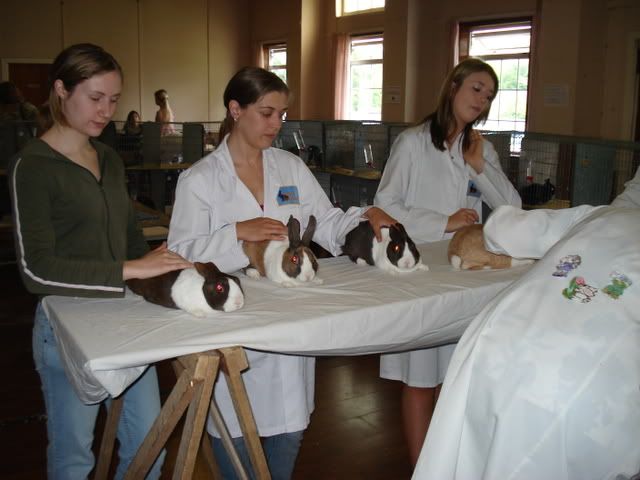
Dutch being judged
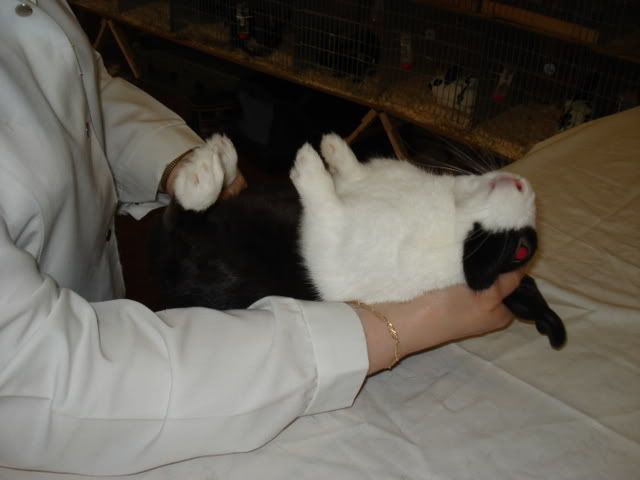
2 day old baby dutch
http://img.photobucket.com/albums/0903/pabrant/babies.jpg
and a little bit older
http://img.photobucket.com/albums/0903/pabrant/babies6.jpg[/align]
National clubs and affiliates.
ARBA - www.arba.net
BRC - www.thebrc.org
American dutch club - http://www.dutchrabbit.com/
greater london dutch rabbit club - http://www.gldrc.moonfruit.com/
[align=left]The dutch rabbit Is popular with fanciers and pet lovers alike whether true or mismarked theymake people fall in love with them. It is a smallish rabbit with very striking markings in a variety of colours including tridutch.[/align]
[align=left]Weighs in at 4 1/2 - 5lbs (2.041-2.26kgs)
[/align]
[align=left]Appearance.[/align]
[align=left]The dutch rabbit isa fairly small and compact rabbit with erect ears and powerful back legs. Popular as a breed they are classed as a white rabbitwearing formal attire. Their markings should be clean cut between the white and the colour, as this is where a lot of the points are awarded when showing. A dutch will alwyas stand out from the crowd!
History.
The dutch rabbit was developed in England during the 1830's. They origionated from a breed called the "petite Brabancon." (which have pictures back as far as the 15th century!)
The Petite Brabancon were brought over from the netherlands for meat and would often display dutch markings! UK breeders selected the rabbts with the ost even markings and changed it into the breed it is today.
Health.
Dutch are generally a very healthy and hardy breed that live on average 5 to 8 years.
Breeding.
Raising well-marked Dutch is not an exact science.You can breed two perfectly marked Dutch together and get a wholelitter of mismarks. You can breed two mismarks and get awhole litter of perfectly marked Dutch. You can breed a doeand a buck once and get a nicely marked litter, breed them again andthe litter is mismarked. The point is that you can't breed for markings. But this obstacle is what makes raising Dutch so much fun.
If you can't breed for markings, how can you breed for a goodDutch? First, when picking out your breeding stock, you must consider type first. A good typed Dutch should have thecompact type comparable to a Mini Rex or Florida White. Goodtype is smooth with full hindquarters and shoulders. What Il ook for is a side profile that is a �u� but broader. Thehead should be as round as possible. Fur should be flybackand shiny. Color will of course, depend on the variety you want. You will want to talk to an experienced breeder about proper color and what colors you can mix. Generally color tocolor (such as black to black) is best.
The most exciting part about raising Dutch is when you get your first litter. You can immediately go through the babies tosee what their markings look like. If you have all mismarks,it's not the end of the world. In most cases, there will bean awesome typed baby in there. You can take the best typed baby, breed it and then get some nicely marked babies. In my experience, the mismarks usually throw the best marked babies.
If you have a couple showable babies, you will need to wait to see what their type turns out like. Showing Dutch isn't justabout markings. Type is just as important. But ifyou start with nicely typed Dutch, you shouldn't have too much to worry about.
The biggest factor in raising good Dutch is patience.But there is nothing more rewarding than getting that Best in Show witha rabbit you raised yourself!
Dutch rabbits will have an average liiter size of 6 though you can expect to see as little as 4 or as many as 10!!
Personality.
Dutch are a very intelligent and easily trained. They do tend to get bored easily, so plenty to interest them is a must! They are known for having a great nature and are very gentle and sociable rabbits. Ideal as a pet or for breeding/showing with.
ARBA standards
Varieties: Black, blue, chocolate, gray, steel, tortoise
Sr. Bucks & Does - 6 months of age or over, weight 3 1/2 -5 1/2 lbs. Ideal weight 4 1/2 lbs.
Jr. Bucks & Does - under 6 months of age. Min weight 1 3/4 lbs
Schedule of points.
Type = 25 points.
Body - 12 pts
head- 5pts
ears- 2 pts
eyes- 1pt
----------------------------
Fur= 10points
colour = 10points
------------------------------
Markings = 50 points
cheeks - 12 pts
Blaze - 5 pts
Neck - 5pts
Saddle - 10pts
Undercut - 8 pts
Stops- 10pts
condition- 5 pts
----------------------
Overall = 100 points.
UK Standard.
Ring size B.
Ears - 10pts short and strong, not pointed at ends and fairly broad at the base.
Eyes - 5pts Bold and bright. should be fairly large
Blaze and cheeks - 15pts Blaze shoud be wedge shaped and carrying up to a point between ears. Cheeks to be as round as possible and come as close to whiskers as possible without touching. Should also cover jaw bone.
Clean neck - 10pts Should be free from coloured fur immediately behind ears.
Saddle - 10pts The junction between white and coloured fur on back. It should be right round the animal and be an even straight line.
Undercut - 10pts To be as near to front legs as possible without touching.
Stops - 15pts White markings on back feet. As close to 3.17 cm (1 1/4") as possible and a clean line right round.
Colour - 10pts
Shape, condition and weight - 15 pts Compact, cobby and rounded. Ideal weight to be 2.041-2.26 KG (4 1/2 - 5 lbs) Hard and firm in flesh Skin tight, Gloss on coat, bright eyes, lively and alert.
Total = 100 points.
Disqualifications.
Wrong coloured eyes, discoloured or wall eyes (pale blue iris) Speckled eyes, coloured fur in the white part or vice versa. Flesh markings (usually on ears) Trimming, Malocclusion or mutilated teeth.
Colours.
Black - Deep, solid and carrying well down to the skin, with blue undercolour, the deeper the deeper the better. Free from white hairs and mealy or flecking. Eyes - dark hazel.
Blue - Deep, solid, slate blue, to carry well down to skin, blue undercolour the deeper the better. Free from white hairs and flecked or mealy coat. Eyes- dark blue.
Chocolate - Deep solid dark chocolate colour carrying well down to the skin. Undercolour to match top colour as near as possible. Free from white hairs and mealiness. Eyes- choclate brown.
Yellow - An even shade of yellow on ears, cheeks, back and upper part of tail, to be carried well down sides, flanks and hind feet. Ideally should be free from chinchillation with no eye circles. Belly colour can be lighter shade toning with top colour, undertail to tone with belly. Eyes - Hazel.
Tortoiseshell - Even shade of orange top colour to carry well down and shading off to a lighter colour to the skin. Ears, belly and under tail to be blue/black. Cheeks and flanks shaded or toned with the blue /black. EYes Hazel
Steel gray - Dark steel merging to pale slate blue undercolour. The whole interspersed with black guard hairs. The medium bright and evenly ticked is the one to aim for and teh extreme tips of fur will be ticked with steel blue or gray. Mixture to carry well down the sides, flanks and feet. Belly colour will be a lighter shade varying with the top colour, upper part of tail to match the body colour underside toning with belly colour. Ears to match body. Eyes - deep hazel
Brown gray - Slate blue at the base followed by a band of yellowy orange then a black line. should finish in light or nut brown tips to fur. SHould be interspersed with black guard hairs. Should be light or nut brown on ears, cheeks, body and hind feet and tail ticked with the black guard hairs. Belly colour and eye circles bright straw colour. A lighter colour permissable under tail. Eyes - hazel.
Pale gray - Top colour biscuit, carrying well down and merging into pale slate at base. The whole interspersed with black ticking. The general impression should be biscuit ticked with black on ears, cheeks, body and top of tail. Belly colour white with pale slate undercolour. Eye circle white but as small as possible. Body colour should be present on hind feet. Underside of tail should be white. Eyes - Hazel.
Table of Dutch being judged for best of breed (UK show)

Dutch being judged

2 day old baby dutch
http://img.photobucket.com/albums/0903/pabrant/babies.jpg
and a little bit older
http://img.photobucket.com/albums/0903/pabrant/babies6.jpg[/align]
National clubs and affiliates.
ARBA - www.arba.net
BRC - www.thebrc.org
American dutch club - http://www.dutchrabbit.com/
greater london dutch rabbit club - http://www.gldrc.moonfruit.com/





